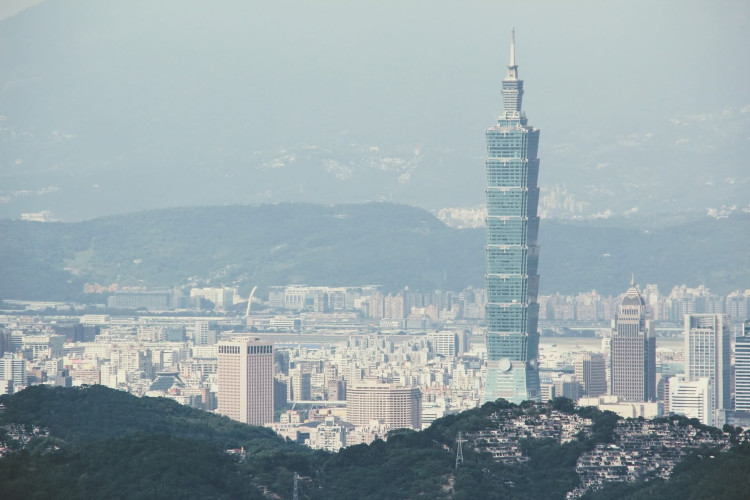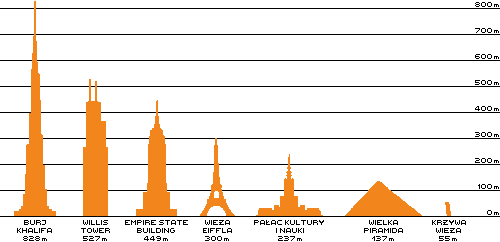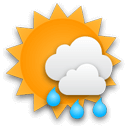Taipei 101 (Taiwan) - 509 meter skyscraper (101 floors)
Where is located Taipei 101?
Address of Taipei 101 is 8, Sung-Chih Road, Taipei, Taiwan
show on map
When was built Taipei 101?
Built date of Taipei 101 is 1994 - 2004

Facts, informations and history of Taipei 101
The entire structure contains 101 above-ground floors and 5 underground floors. On the 89th floor there is an internal observation room, while the external observation deck is located on the 91th floor.
The external observation deck will be the second highest in the world, will be exceeded only by the Shanghai World Financial Center.
To Taipei 101 will be 3 out of 4 titles of the Supreme Building in the World at the moment when the skyscraper will be built: Building with the highest structural point, the highest to the roof and building with the most occupied floor.
It will be one of several buildings in the world equipped with two-deck lifts.
Each elevator is designed with an aerodynamic shape, a pressure stabilizer, an emergency braking system, and the world's first three-state anti-overrun system. The cost of each lift will be over 2 million dollars.
The building will have the fastest lifts in the world traveling upwards at a speed of 1008 meters / minute (60.48 km / h) and down 610 m / min. (36.6 km / h). The passengers will need only 39 seconds to reach the 90th floor. The highest speed is 34 percent faster than the current speed of the fastest elevators in Yokohama Landmark Tower .
It is one of several very tall buildings in the world where design inspiration comes from traditional Chinese buildings.
The specification and design of the tower are based on the number "8", which is a happy number in traditional Chinese culture. Apart from the 8-part building structure, its colorful glass reflecting the sky is decorated with traditional Ruin symbols. This type of project (called "8-design") was also widely used when Jin Mao Tower in Shanghaju.
The only problem according to C.P.Wang - architect and Feng Shui specialist was the road that ran towards the building, which could cause illnesses and hinder the interests of officials. This was simply repaired by the construction of a fountain blocking the road.
The official opening ceremony of the ceremony's roof ceremony took place on July 1, 2003. The President of Taiwan and the Mayor of Taipei participated in this event. Taipei 101 now maintains the title of the tallest building in the world measured to the top of the roof, beating the previous owner of this record Willis Tower .
The final part of the top of the tower, with a 197 feet long spire, was placed on October 9, 2003, thus Taipei 101 became the holder of the official title of the Supreme Building.
Mayor Taipei Ma Ying-jeou at the ceremony on October 17, 2003 fixed the golden shaft marking the official completion of the tower.
The building will contain stores, offices for 12,000 employees and a Taiwanese exchange, which will rent 7 floors in the building.
This is the first and only superwysoki skyscraper in the world, which is built on a very active zone of shakes caused by earthquakes. For this purpose, the first 62 floors are supported by huge steel columns filled with very durable concrete. The rest is lighter, made mainly of steel and glass. Lin claims that the structure will withstand earthquakes up to 7 on the Richter scale (in October 1999, Taiwan hit 7.6 magnitude earthquake) and survive typhoons at speeds up to 180 ft / sec. If, on the other hand, a building such as in the tragedy of 11/09/01 was hit, then Taipei 101 will be for a long time longer than World Trade Center .
Petronas Tower 1 and Petronas Tower 2 they will still be holders of the title of the highest twin towers in the world despite the fact that Taipei 101 will be the highest building in the world.
A weighing 800 ton stabilizing system will help stabilize the tower. This system will be located in a circular structure near the top of the building, between the restaurant level and the observation deck.
" We have designed this building based on the philosophy of integration with nature. " - C.P. Wang, chief architect.
" This is like a growing plant to reach heaven, which is very different from the western idea of acquiring nature. " - C.P. Wang
" Feng shui is part of our culture, so we built these symbols to help people feel happiness. " - C.P. Wang
Architect of Taipei 101

How many meters have Taipei 101?
Height of Taipei 101 is 509 meters (1671 ft)


Construction/building type
Building Taipei 101 is of type Skyscraper, Office building
Architectural style
Architectural style of Taipei 101 is Postmodernism
Postmodernism is an architectural style that emerged in the 1970s and lasted until the late 1990s. It is characteristic of architecture after modernism, which was more abstract and minimal. Postmodernism rejects the abstract and minimalist approach to design and focuses on the usability, functionality and aesthetics of buildings. ... czytaj więcej.
What material is the building made of?
Taipei 101 is made of the following materials: steel, reinforced concrete, glass
Cost
Build cost of Taipei 101 is 1.7 billion dollars
Other names
The building is also known by other common names or in the original language, i.e. Taipei Financial Center
Official website
The official website of the building, where up-to-date information can be found, is http://www.taipei-101.com.tw
Photo gallery Add photo
Location on map / How to get there





























Comments to Taipei 101 (215) Average rating: 4,0 Add comment / Rate building
Based on 215 comments